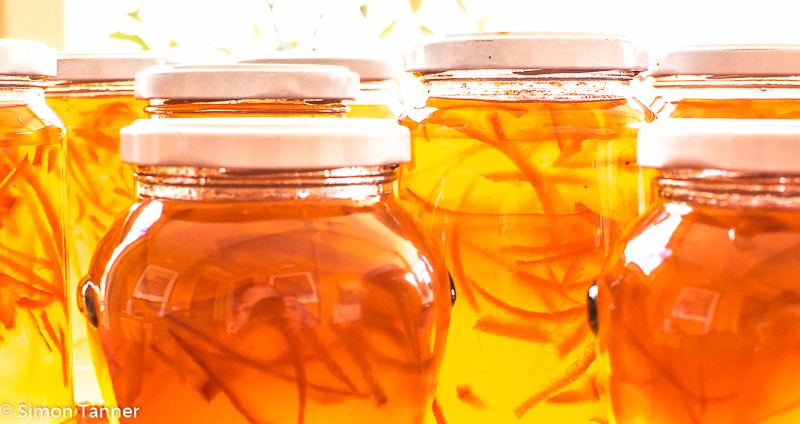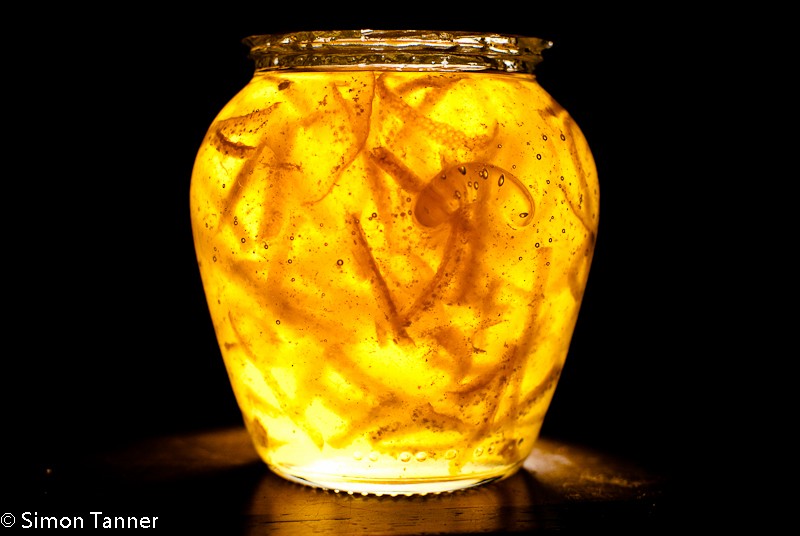 This is the point where I could get all smug and tell you about limoncello and lemon marmalade produced from my own crop of lemons. Well, I could if a) I had anything that could honestly be called a “crop”, since even in a good year, we’re talking about a single tree; and b) if this were a good year, which it is not, not by a long shot, due to over-zealous pruning by a psychopathic gardener last spring. This year’s crop was three lemons. Just about enough for a round or two of gin and tonics.
This is the point where I could get all smug and tell you about limoncello and lemon marmalade produced from my own crop of lemons. Well, I could if a) I had anything that could honestly be called a “crop”, since even in a good year, we’re talking about a single tree; and b) if this were a good year, which it is not, not by a long shot, due to over-zealous pruning by a psychopathic gardener last spring. This year’s crop was three lemons. Just about enough for a round or two of gin and tonics.
So down to the farmers’ market it was… And while stocking up on lemons and chatting with my fruit and veg pusher about marmalade, I asked if he had any bitter oranges. I knew they grew here, but Sicilians tend to shy clear of the quintessential English breakfast preserve, preferring to make their orange marmalade with the sweet variety. Hence, you can’t buy them anywhere. However, my source told me that every orange grove has the odd tree of arancia selvatica, wild orange, because they help with pollination or something. Whether or not they actually are wild, whether or not they are the same as Seville oranges, and exactly how they help with pollination currently remain a mystery to me. But the marmalade they produce tastes as English as you could imagine, so who cares?
Anyway, to cut a long story short, my pusher said he could pick a plentiful supply of what I needed from his own trees, and the following week presented me with a six-kilo bag of them. And with typical Sicilian generosity he wouldn’t hear of being paid. He got a jar of the end product in return, but I don’t know if his Sicilian taste buds appreciated it. What I do know is that I got a good bargain. Fifteen jars of the best marmalade you could imagine for the price of a couple of bags of sugar. So if you happen to know an orange farmer, then bitter orange marmalade is there for the making, hence today’s second recipe. English recipe, Sicilian raw materials – often a great combination. My homemade bacon using half-wild suino nero pork is another example, but that’s another story…
Marmalades for me epitomise the magic of cookery. In the case of lemon there are only two ingredients (ok, three if you count the water), whose initial appearance give no clue as to what the final result will look like. What better way to use the last of the year’s citrus crop? The recipes may sound complicated, but are actually very simple. They are however time-consuming, so set aside a whole afternoon. Rest assured, they are worth every minute…
These marmalades are obviously made for hot buttered toast, but if you want to be very neo-Sicilian chic, they go well with ricotta or mild provola as part of a cheeseboard.
marmellata di limoni – lemon marmalade
For about 7 standard jam jars (370 ml each):
- 1 kg lemons (unwaxed, organic, picked by yourself… get the best you can).
- 2 kg sugar
- Put two saucers in the freezer. The reason for this seemingly bizarre, gratuitous act will become clear, so bear with me.
- Wash the lemons and place them in a large saucepan with 2.5 litres of water. Bring to the boil, then cover and simmer for 2½ hours, by which time it should be easy to pierce the skins with a fork. When the lemons are ready, remove the pan from the heat.
- Using a slotted spoon, remove the lemons from the pan and measure the cooking water left. You will need 1.5 litres in total, so top up with extra water if necessary. If the water is already over 1.5 litres, reduce until you have the required quantity.
- Cut the lemons in half, and using a spoon, scoop out the pips, pith, flesh and all, over a bowl so as not to lose the juice. Pour the contents of the bowl into a sieve lined with muslin over the pan containing the cooking water, so that the juice filters through. Using string, tie the muslin containing the pips and flesh into a bag.
- Cut the lemon zest into thin slivers and place in the pan.
- Place the muslin bag in the pan too – the pips and flesh are high in pectin and help the marmalade to set. Add the sugar and bring to the boil, stirring to ensure the sugar dissolves.
- Boil rapidly for around 20 minutes until setting point is achieved. This is where those saucers come in. Take one from the freezer and spoon a teaspoon’s worth onto the saucer and leave for one minute. Touch delicately with your finger and see if it wrinkles. If it does, it’s ready. If not, continue cooking for a couple of minutes and try again. In any case, do not boil for any longer than 25-30 minutes. You should remember that the marmalade firms up significantly when it cools down, so even if it still seems too liquid to you after this time has passed, stop cooking anyway, Don’t trust your instincts here, at least not the first time. Trust me instead.
- Leave the marmalade to cool for 10-15 minutes, remove the muslin bag, and then stir gently to dissolve any foam that may have formed on the surface.
- Pour into still hot, freshly sterilised jars, seal and label.
By the way, to sterilize jars:
Wash the jars, lids and the funnel you will use to fill the jars in hot water. Put the jars in an oven at 160°C for 30 minutes. Put the lids and funnel in a saucepan of boiling water for ten minutes, then drain and dry.
marmellata di arance amare – bitter orange marmalade
Makes 15 standard jars’ worth
- 2 kg bitter (Seville) oranges
- 2 lemons, juice only
- 4 kg preserving or granulated sugar
Method
- Put two saucers in the freezer (you know why this time). Put the whole oranges and lemon juice in a large saucepan with 3 litres water. The fruit needs to be submerged, so if it isn’t, put a round dish or oven tin on the surface of the water with weights on top if necessary. You may even need to change pans. It doesn’t matter; just do what it takes to keep those oranges underwater. Put a lid on the pan, turn up the heat and bring to the boil, then lower the heat and simmer very gently for around two hours, by which time you should be able to easily pierce the peel with a fork. When the oranges are ready, remove the pan from the heat.
- Using a slotted spoon, remove the oranges from the pan and set aside. Allow the oranges to cool a little and then cut in half. Using a spoon, scoop out the orange’s contents – pips, pith, flesh and all – and add to the orange liquid in the pan. Make sure you scrape the skin well, so that you only leave the zest, which you should set aside. Bring the orange liquid to the boil and cook over a high heat for 6 minutes, then strain through a sieve into a bowl, pressing the pulp through with a spoon.
- Pour the strained liquid back into the saucepan, after having rinsed it. Using a sharp knife (the Japanese are kings here), cut the peel into fine shreds. Add the peel to the liquid in the pan with the sugar. Stir over a low heat until all the sugar has dissolved (about 5 minutes), then whack up the heat and bring to the boil. Cook at a steady boil for 15- 25 minutes until setting point is achieved (see the lemon marmalade recipe above for details on how to test for this). As above, remember that the marmalade thickens significantly when it cools right down, so even if it still seems too liquid to you after 25 minutes, stop cooking anyway.
- Take pan off the heat and skim any scum from the surface. Leave the marmalade to stand in the pan for 20 minutes and then pot in still hot, freshly sterilised jars, seal and label.
- Serve with hot buttered toast, of course.


 English
English